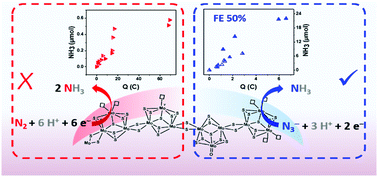Kun Yang, Matthieu Koepf and Vincent Artero
Chem. Commun., 2020,56, 13975-13978
DOI:
10.1039/D0CC05078D,
Communication
Ammonia (NH3) is a major feedstock of the chemical industry. The imperious need to decarbonize its production has stimulated a quest for efficient catalysts able to drive the direct electro-reduction of dinitrogen (N2) into NH3. A large number of materials have now been proposed for this reaction, including bioinspired molybdenum sulfide derivatives. Here, we revisit the potential of amorphous molybdenum sulfide to drive the electrocatalytic reduction of N2 and other substrates of nitrogenase. We find that this material exhibits negligible activity towards N2 but achieves efficient reduction of inorganic azides.
